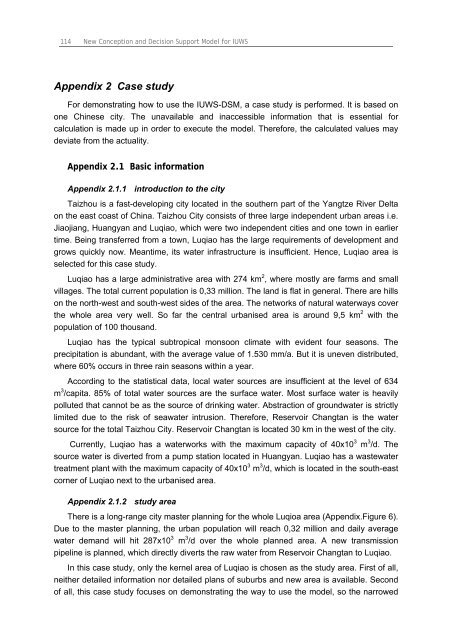Chapter 3 Decision Support Model (IUWS-DSM) - Tubdok
Chapter 3 Decision Support Model (IUWS-DSM) - Tubdok
Chapter 3 Decision Support Model (IUWS-DSM) - Tubdok
Create successful ePaper yourself
Turn your PDF publications into a flip-book with our unique Google optimized e-Paper software.
114 New Conception and <strong>Decision</strong> <strong>Support</strong> <strong>Model</strong> for <strong>IUWS</strong><br />
Appendix 2 Case study<br />
For demonstrating how to use the <strong>IUWS</strong>-<strong>DSM</strong>, a case study is performed. It is based on<br />
one Chinese city. The unavailable and inaccessible information that is essential for<br />
calculation is made up in order to execute the model. Therefore, the calculated values may<br />
deviate from the actuality.<br />
Appendix 2.1 Basic information<br />
Appendix 2.1.1 introduction to the city<br />
Taizhou is a fast-developing city located in the southern part of the Yangtze River Delta<br />
on the east coast of China. Taizhou City consists of three large independent urban areas i.e.<br />
Jiaojiang, Huangyan and Luqiao, which were two independent cities and one town in earlier<br />
time. Being transferred from a town, Luqiao has the large requirements of development and<br />
grows quickly now. Meantime, its water infrastructure is insufficient. Hence, Luqiao area is<br />
selected for this case study.<br />
Luqiao has a large administrative area with 274 km 2 , where mostly are farms and small<br />
villages. The total current population is 0,33 million. The land is flat in general. There are hills<br />
on the north-west and south-west sides of the area. The networks of natural waterways cover<br />
the whole area very well. So far the central urbanised area is around 9,5 km 2 with the<br />
population of 100 thousand.<br />
Luqiao has the typical subtropical monsoon climate with evident four seasons. The<br />
precipitation is abundant, with the average value of 1.530 mm/a. But it is uneven distributed,<br />
where 60% occurs in three rain seasons within a year.<br />
According to the statistical data, local water sources are insufficient at the level of 634<br />
m 3 /capita. 85% of total water sources are the surface water. Most surface water is heavily<br />
polluted that cannot be as the source of drinking water. Abstraction of groundwater is strictly<br />
limited due to the risk of seawater intrusion. Therefore, Reservoir Changtan is the water<br />
source for the total Taizhou City. Reservoir Changtan is located 30 km in the west of the city.<br />
Currently, Luqiao has a waterworks with the maximum capacity of 40x10 3 m 3 /d. The<br />
source water is diverted from a pump station located in Huangyan. Luqiao has a wastewater<br />
treatment plant with the maximum capacity of 40x10 3 m 3 /d, which is located in the south-east<br />
corner of Luqiao next to the urbanised area.<br />
Appendix 2.1.2 study area<br />
There is a long-range city master planning for the whole Luqioa area (Appendix.Figure 6).<br />
Due to the master planning, the urban population will reach 0,32 million and daily average<br />
water demand will hit 287x10 3 m 3 /d over the whole planned area. A new transmission<br />
pipeline is planned, which directly diverts the raw water from Reservoir Changtan to Luqiao.<br />
In this case study, only the kernel area of Luqiao is chosen as the study area. First of all,<br />
neither detailed information nor detailed plans of suburbs and new area is available. Second<br />
of all, this case study focuses on demonstrating the way to use the model, so the narrowed

















